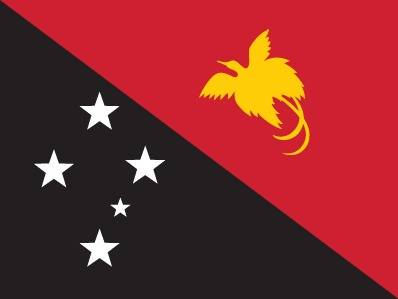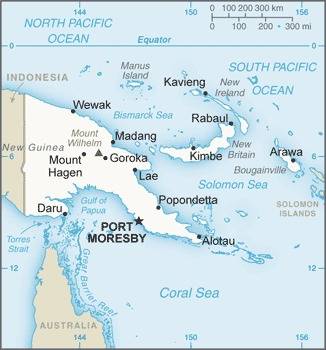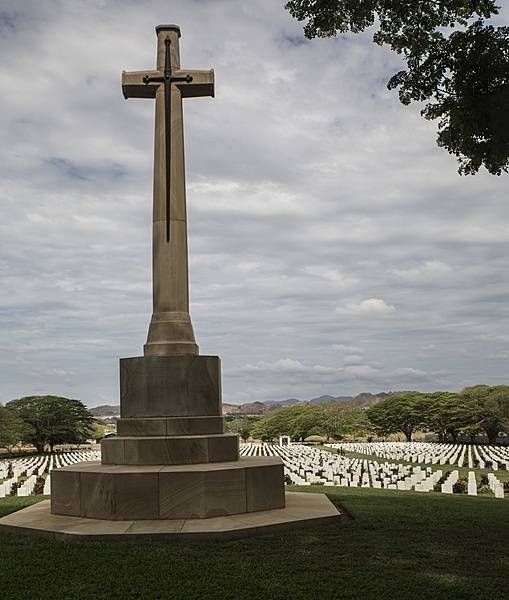48 Papua New Guinea

Divided diagonally from upper hoist-side corner. The upper triangle is red with a soaring yellow bird of paradise centered. The lower triangle is black with five, white, five-pointed stars of the Southern Cross constellation centered. Red, black, and yellow are traditional colors of Papua New Guinea. The bird of paradise – endemic to the island of New Guinea – is an emblem of regional tribal culture and represents the emergence of Papua New Guinea as a nation. The Southern Cross, visible in the night sky, symbolizes Papua New Guinea’s connection with Australia and several other countries in the South Pacific.
Flag courtesy of the CIA World Factbook

Map courtesy of the CIA World Factbook

A view of the Cross of Sacrifice at the Bomana War Cemetery near Port Moresby. The cemetery is the final resting place of more than 3,800 Allied service members – Australian and Papuan – who successfully fought to prevent the Japanese Empire from taking Papua New Guinea in World War II.
Photo courtesy of the CIA World Factbook
Government
According to Britannica, Papua New Guinea’s constitution was adopted in 1975 and has been amended frequently since then. The country is a constitutional monarchy and a member of the Commonwealth. The British monarch, represented by a governor-general, is head of state, and the prime minister is head of government. The unicameral National Parliament has 111 members who are elected to serve five-year terms. Of those, 89 represent single-member “open” electorates (districts); each of the other 22 represents one of the provincial electorates. Parliament nominates the governor-general, who is then appointed by the British monarch. Parliament also elects the prime minister, who in turn appoints the ministers of the National Executive Council (cabinet).
Provincial-level government formerly consisted of 19 elected provincial assemblies and their executives. In 1995 the National Parliament instituted reforms that replaced this system with one in which the members of Parliament (MPs) who were elected to represent the provinces usually became the provincial governors while retaining their seats in the National Parliament. MPs from the “open” districts constitute the membership of the provincial assemblies along with presidents of local-level councils. This has meant that national legislators effectively control executive government at local levels. Although the parliamentarians gained control over considerable funds for their electorates, few provinces have seen appreciable benefits, and in most districts the coverage and quality of government services declined markedly after 1995.
Papua New Guinea’s judicial system has at its base a network of district courts presided over by magistrates. The higher-level National Court has the power of judicial review over the lower courts and handles serious civil and criminal matters. The Supreme Court is the final court of appeal, and it also reviews the decisions of the National Court and issues rulings on the constitutionality of laws. The Ombudsman Commission is a significant constitutional body with a major role in monitoring the ethical behavior of national leaders under the Leadership Code—a set of ethical guidelines and responsibilities for state officers that is established in the constitution—as well as monitoring public administration.
The courts have dealt increasingly with political disputes over elections, constitutional and parliamentary matters, and Leadership Code cases. Below the formal court system but not integrated into it is a network of more than 1,000 village courts run by part-time local community appointees; these use customary law, mostly in dispute resolution aimed at preventing the escalation of local conflicts. Village court magistrates, almost all male, are assisted by local peace officers. Each province has a system of correctional institutions.
Civil Aviation Safety Authority of Papua New Guinea
The Civil Aviation Safety Authority of Papua New Guinea was established in 2010 by the Civil Aviation Act 2000 (as amended). CASA PNG is a statutory body with legal mandate to promote aviation safety and security through effective safety regulation of the civil aviation industry, with particular emphasis on preventing aviation accidents and incidents within the civil aviation system in Papua New Guinea.
Pacific Aviation Safety Office (PASO)
The Pacific Aviation Safety Office (PASO) is an international organization providing quality aviation safety and security service for Member States in the Pacific.
PASO is the sole international organization responsible for regional regulatory aviation safety oversight service for the 10 Pacific States who are signatories to the Pacific Islands Civil Aviation Safety and Security Treaty (PICASST).
The current PICASST signatories are the Pacific nations of Cook Islands, Kiribati, Nauru, Niue, Papua New Guinea, Samoa, Solomon Islands, Tonga, Tuvalu, and Vanuatu. Associate Members of PASO are Australia, Fiji and New Zealand. Government representatives from these nations make up the PASO Council.
Airspace
SkyVector – Google Maps – ADS-B Exchange
ICAO countries publish an Aeronautical Information Publication (AIP). This document is divided into three parts: General (GEN), En Route (ENR) and Aerodromes (AD). ENR 1.4 details the types of airspace classes they chose to adopt from classes A through G.
Drone Regulations
Part 101 – Gyrogliders and Parasails and Unmanned Aircraft (including balloons), Kites and Rockets – Operating Rules
Part 102 – Unmanned Aircraft Operator Certification and Operation
AC 101-1 – Remotely Piloted Aircraft Systems Below 25kg
AC 102-1 – Unmanned Aircraft -Operator Certificate
Advanced Air Mobility (AAM) Regulations & Policies
Advanced Air Mobility (AAM) News
None found by the author.
However, should you, the reader, happen to stumble across something to the contrary, please email the author at FISHE5CA@erau.edu and you may be mentioned in the ACKNOWLEDGEMENTS section of this book by way of thanks for contributing to this free eBook!
Short Essay Questions
Scenario-Based Question
You have been hired by a Drone Startup Company. Your boss has immediately assigned this job to you.
They need you to prepare a one-page memo detailing the legalities of using a drone outside the Bomana War Cemetery near Port Moresby, pictured above.
They need you to mention any national laws and local ordinances.
They specifically want to know what airspace (insert pictures) you will be operating in and whether or not you need an airspace authorization.
Does it matter whether or not you are a citizen of the country?
Lastly, there is a bonus for you if, as you scroll through this chapter, you find any typos or broken links!
Short Essay Questions
- What are the drone categories?
- How is registration addressed?
- How is remote ID addressed?
- What are the model aircraft rules?
- What are the commercial drone rules?
- Are there waivers or exemptions to the rules? If so, for what?
- Would you share a link to an interactive airspace map?
- How is BVLOS addressed?
- How can you fly drones at night?
- How can you fly drones over people?
- Where do you find drone NOTAMs?
- What are the rules for drone maintenance?
- What are the rules for an SMS program?
- What are some unique rules not mentioned above?
- What are the C-UAS rules?
- What are the AAM rules?

